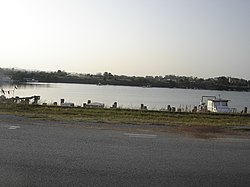Alyki (Central Macedonia)
|
Alyki Αλυκή |
||
|---|---|---|
|
|
||
| Basic data | ||
| Country |
|
|
| region | Central Macedonia | |
| Regional district | Pieria | |
| local community | Pydna-Kolindros | |
| Parish | Pydna | |
| Local community | Pydna | |
| Geographic coordinates | 40 ° 22 ′ N , 22 ° 37 ′ E | |
| Residents | 34 (2011) | |
| LAU-1 code no. | 1103040102 | |
Alyki ( Greek Αλυκή , ( f. Sg. )) Is a village in the municipality of Pydna-Kolindros in the Greek region of Central Macedonia . It is best known for the salt pans and, together with Kitros, forms an administrative unit. Nearby are the ruins of ancient Pydna and the village has sandy beaches and a lagoon with salt marshes where salt is extracted . Until 1927 the place was called Touzla (Τούζλα).
Salt pans
The salt production reached 40,000 tons per year and takes place between March and October.
Salt marsh
The area around the saline is a lagoon (λιμνοθάλασσα) with a salt marsh, which is now under protection. The swamp is a hydrobiotope and resting place for sea birds of national importance. A pointer plant of the salt marshes is the dune funnel-shaped daffodil (κρίνος της θάλασσας - Pancratium maritimum) and there is a larger colony of black-headed gulls (μαυροκέφαλοι γλάροι - Larus melanocephalus), but their population has declined since 1989. The dune fringes (αμμοθίνες) is a special feature of the Kitros lagoon and is the largest in terms of width and area with such vegetation in northern Greece. Due to the directive (Οδηγία) 92/43 of the European Union , Aliki was added to the Natura 2000 network with the number GR 1250004 .
Salt pans
The salt pans of Kitros (αλυκές του Κίτρους) are located very close to the beach of Kitros, near the ancient Atherada (Αθεράδα). The area is actually 5 km from Kitros. The port of ancient Pydna is also believed to be there. The total area of the salt pans is around 10,000 ha. The lake, which is used as a warm-up zone, comprises around 1,440 ha. (It is therefore called "Thermastres" - θερμάστρες.) The remaining area is taken up by 140 so-called "pans" (alopygia αλοπήγια; "τηγάνια" tigania). The saltworks is in fifth place among the largest salt producers in Greece .
history
There are few data on how long salt has been mined. It is believed, however, that salt mining began in Macedonia during the Ottoman rule . The first description of the salt pans comes from the Venetian traveler Giovanni Atziolelo (Τζιοβάννι Ατζιολέλο), who writes in his diary that Kitros has "many salt pans". Salt production has been in the hands of the state since the 1970s.
literature
- Alekos Angelidis (Αλέκος Αγγελίδης): Αναδρομή στην Ιστορία της Μακεδονίας (Journey into the History of Macedonia), εκδόσεις ΜΑΤΙ, 1992. pp. 490-498.
Web links
- Υδροβιότοπος Αλυκής Κίτρους, στον Γενικό Τουριστικό Οδηγό του Νομού Πιερίας - Description of the nature reserve (Greek).
- Υδροβιότοπος Αλυκής Κίτρους, στο ΕΜΠ Φιλότης- Βάση Δεδομένων για την Ελληνική Φύση
Individual evidence
- ↑ Results of the 2011 census at the National Statistical Service of Greece (ΕΛ.ΣΤΑΤ) ( Memento from January 7, 2013 in the Internet Archive ) (Excel document, 2.6 MB)
- ↑ Τουριστικός Οδηγός νομού Πιερίας
- ↑ Νομός Θεσσαλονίκης / Παραγωγή αλατιού στην αλυκή Κίτρους Salt production in Kitros (Greek)
- ↑ Καθημερινή, Νομός Πιερίας: Χειμωνιάτικες εξορμήσεις γύρω από τον Όλυμπο , ανακτήλυμπο , ανακτήηκε 17/1/2008 ( page : the link was automatically marked as defective , search in the web archives 17/1/2008 : the link was no longer available ) Please check the link according to the instructions and then remove this notice. (Greek).
- ↑ το Κίτρος "με τις πολλές αλυκές"

